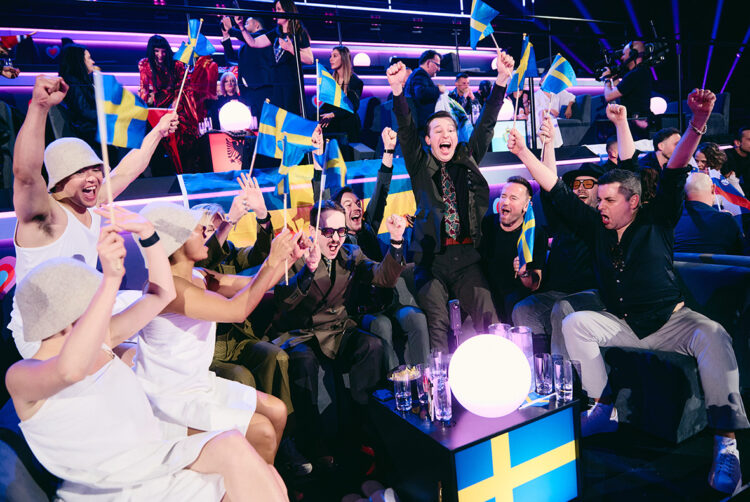Eurovision 2025: The second screen is the first place to win big

Opinion
With 170m viewers up for grabs, the real winners of Eurovision are brands that capture attention across the digital touchpoints that the TV audience is highly engaged in.
With over 170m viewers worldwide, the Eurovision Song Contest is one of the biggest cultural moments of the year. Yet, most brands overlook it because there are no traditional TV ad breaks.
But Eurovision is not a passive viewing event — it’s one of the most active second-screen environments of the year. While the main screen delivers whacky songs and crazier outfits, the Eurovision TV audience is also highly engaged across digital touchpoints — posting TikToks, ordering Uber Eats and sharing their opinions on X in real time.
And this is where attention is up for grabs.
Second-screening is the main event
Despite what we like to believe, we don’t really multitask when watching TV — we screen-switch. Data from attention panels run by Lumen partner TVision in the UK suggests that when the ads come on, the phones come out.
Only around 50% of TV ads get any visual attention at all; we’re busy talking to the family or checking out TikTok while the ads play out. Half the time, your audiovisual TV ad is in “radio mode”.
This behavioural data is corroborated by BT’s latest Network Wrapped study, which asked viewers what they are really doing during major cultural TV events such as Eurovision. Half (47%) of Brits scroll social media, 39% message friends and family, and 33% shop online.
That means attention is divided, yes, but it’s also intentional.
During Eurovision, the second screen isn’t a distraction; it’s the first opportunity for engagement. The most valuable currency in advertising isn’t what gets displayed on a screen — it’s what people actually choose to look at and engage with. It’s this real human attention that shapes behaviour and drives outcomes for brands.
That’s why culturally relevant, multichannel strategies are essential for brands looking to win. TikTok’s Super Bowl campaign showed the power of second-screen strategies, with the platform driving online conversation through partnerships with brands and creators.
While Eurovision has inspired campaigns before, this year presents an even bigger opportunity for brands to fully own the digital conversation and stand out where attention is already high.
Windows to the soul: The compelling relationship between attention and profit
Culturally relevant campaigns that work harder
Not all media channels are created equal when it comes to capturing real attention. Brands need to move beyond simply showing up everywhere and start selecting channels based on their ability to drive impact, not just reach.
That’s where attention data comes in, helping marketers choose media environments that convert fleeting glances into lasting outcomes.
Eurovision offers exactly this kind of opportunity: the chance to run highly targeted, culturally relevant campaigns that appear in the right place, at the right moment, for the right audience.
Research from Uber Advertising and Lumen shows that in-app ads can achieve over 50% recall in just 2.5 seconds, generating a 27% uplift in consideration.
This effectiveness isn’t random; it’s powered by smart first-party data and contextual targeting that meets audiences where their attention is already high. Additional research from Magna backs this up, showing that aligning ads with culturally relevant moments like Eurovision can triple purchase intent and double search activity.
Eurovision gives marketers the perfect moment to apply this thinking beyond TV — activating attention across social, search and display to drive engagement.
Don’t count views — measure attention
To turn cultural moments like Eurovision into real brand impact, marketers must shift their focus from what is seen to what is truly engaged with.
By measuring how long and how deeply people engage with your campaign, attention metrics show the true impact on outcomes like awareness, consideration and purchase intent.
Our research with Havas and Brand Metrics proves this, showing meaningful uplifts when campaigns are optimised for attention — not just reach.
And the business case is clear. Ebiquity’s study with Lumen found an almost perfect correlation (0.98) between attentive seconds per thousand impressions and profit, proving that attention isn’t just a marketing metric — it’s a commercial driver.
With 170m viewers up for grabs, the real winners of Eurovision won’t be on stage — they’ll be the brands that capture attention where it really counts.
Attention is a finite resource, but it’s fast becoming the new currency of effective advertising, overtaking outdated metrics like viewability. Eurovision gives marketers the perfect moment to prove this by turning split-second engagement into long-term brand impact.
 Mike Follett is founder and CEO of Lumen
Mike Follett is founder and CEO of Lumen




